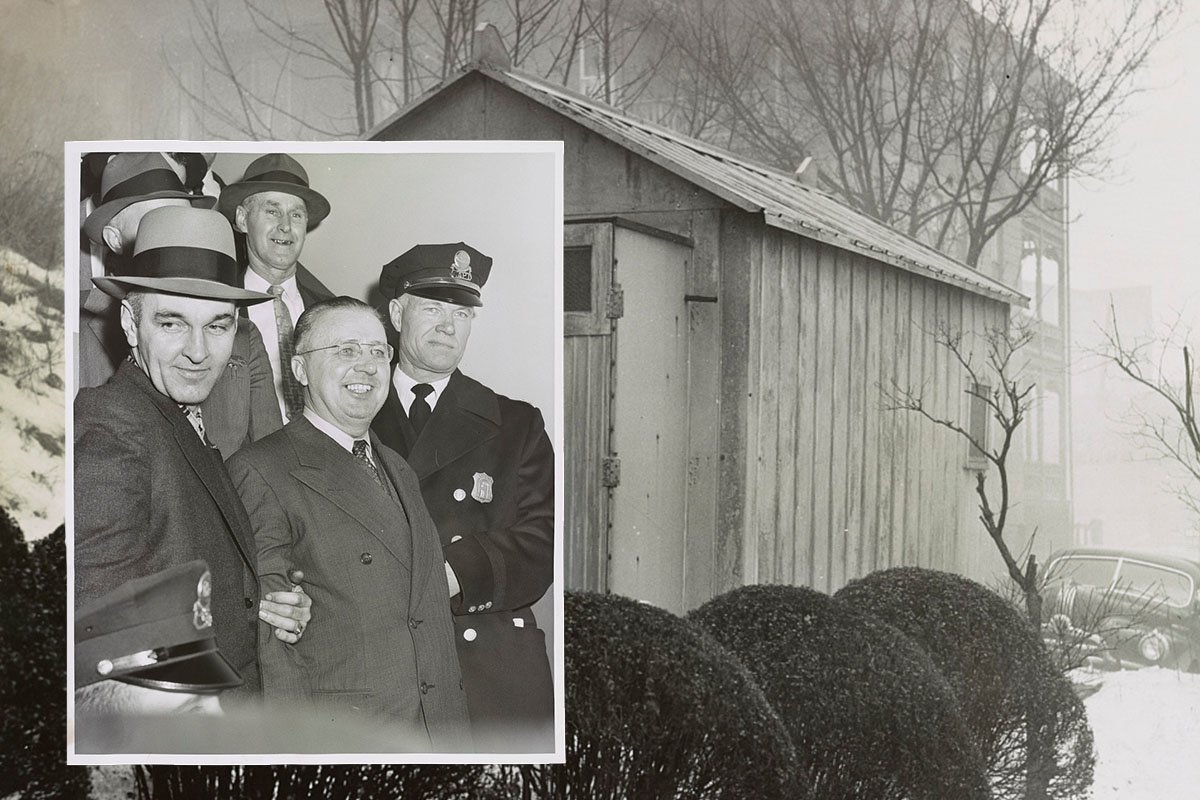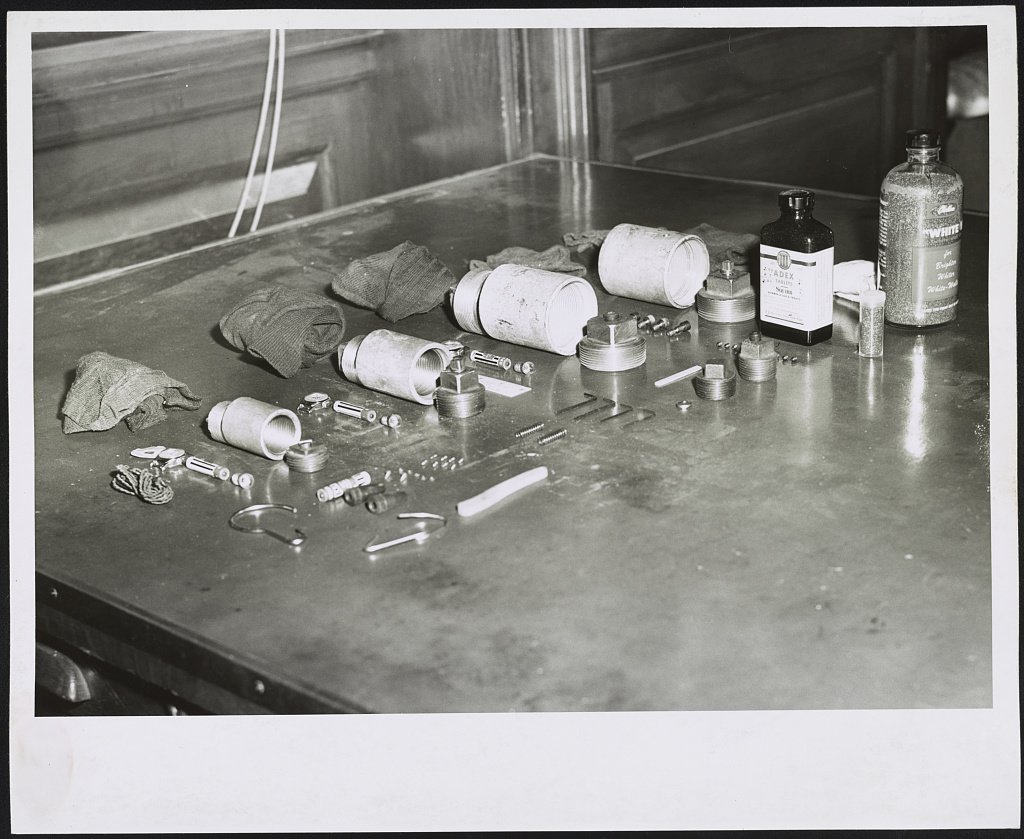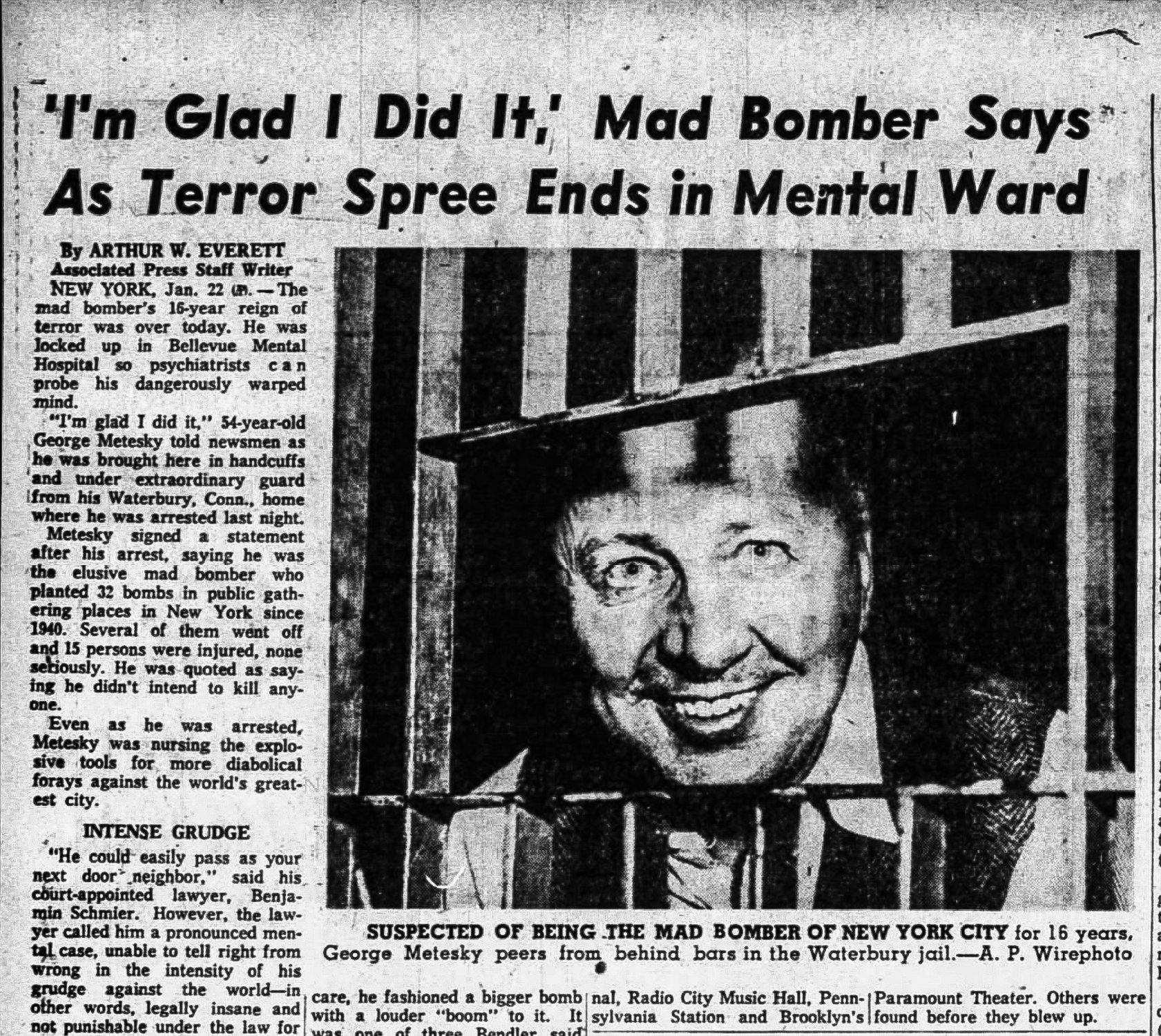The ‘Mad Bomber’ Who Terrorized NYC Subways and Streets for 16 Years

George Metesky at Waterbury, Connecticut, police headquarters — wearing a buttoned double-breasted suit, as predicted in a groundbreaking criminal profile. In the background, the garage where Metesky made his bombs. World Telegram & Sun photos by Phil Stanziola and Ed Ford/Library of Congress. Composite by Coffee or Die Magazine.
A mysterious bomber terrorized New York City for 16 years, targeting subways, offices, homes, and sidewalks, leaving police baffled.
But the New York City Police Department ultimately cracked the case using the then-groundbreaking investigative strategy known as criminal profiling. The case marked one of the earliest instances of criminal profiling being used successfully; the investigation led authorities to a previously unsuspected lone-wolf suspect named George Metesky. Until he was caught, newspapers had labeled him the “Mad Bomber.”
The Mad Bomber terror spree began when Metesky, 37, planted a homemade pipe bomb on a Consolidated Edison powerhouse on West 64th Street. A worker on his lunch break discovered the unexploded device in a wooden box on a windowsill on Nov. 18, 1940.
“Con Edison crooks, this is for you,” read the note inside the box, cryptically signed with the initials F.P., later determined to stand for “Fair Play.”

Metesky anonymously penned more notes immediately after news broke and sent the threatening letters to the police, newspapers, and his workplace, Consolidated Edison.
The unexploded device and menacing letters served as the opening act for the Mad Bomber, whose terror spree tormented New Yorkers between 1940 and 1957.
Metesky planted a second bomb in 1941 in downtown Manhattan, but it, too, didn’t detonate.
“I was very careful,” he later said in an interview. “I meticulously removed all my fingerprints whenever I planted a bomb and in mailing my letters, I carried with me a small piece of cloth and wiped the envelope clean.”
Then, unexpectedly, the case of the mystery bomber went cold; for nearly 10 years, Metesky stopped planting bombs. But on March 29, 1951, some 10 and a half years after the first bomb was discovered, Metesky struck again, this time at the heart of the NYC subway system at Grand Central Terminal. It was the first of Metesky’s bombs to go off. A phone rang at the Grand Central Oyster Bar & Restaurant following the explosion.
“Was there much damage?” a man with a foreign accent asked.
No one was killed.
The Mad Bomber increased his attacks, hitting various public locations, including office buildings, bus terminals, libraries, and movie theaters.
“He would sit in the orchestra,” writer Michael Cannell said in The New Yorker project The Mad Bomber Who Terrorized Manhattan. “When the lights came down, he would take out a cheap penknife, and he would rip open the upholstery of an adjacent seat and place his homemade bomb into the upholstery.”
The NYPD, baffled by the question of the Mad Bomber’s true identity, uncovered no evidence of copycat crimes and declared the suspect’s actions were that of a lone-wolf criminal. The NYPD recognized the Mad Bomber’s signature handiwork among the total 32 known bombs he planted.
In an era before DNA examination, the NYPD conducted its investigation of the evidence in the manner it always had. But Capt. Howard Finney, who led 10 bomb squad detectives, contacted psychiatrist James Brussel to assist in the case. Brussel examined the evidence for two hours and created a criminal profile for the suspect.

Brussel determined the suspect likely lived in a northern suburb of the city, had never had a girlfriend, had a history of workplace disputes, and came from a Slavic background. Brussel added that, when the police caught the man, he’d be wearing a buttoned double-breasted suit.
“The reason he got that profile correct had to do with his being presented evidence that contained usable clues, his psychiatric insight to what some of those clues might mean,” forensic psychiatrist Dr. Park Dietz told The New Yorker. “His inference that the killer would be of Slavic origin was based on his knowledge that bombing was favored in middle Europe, the use of stabbing was frequent in middle Europe, the use of both together implied this person would have been influenced by their ancestors.”
Brussel instructed Finney to release his findings to the public to garner a response from the suspect, who wouldn’t be able to resist setting the record straight. The Mad Bomber wrote back to the New York Journal-American newspaper, and with each response, the NYPD learned additional information about the suspect.
The new information led the NYPD to investigate a file for disgruntled employees at Con Edison. The NYPD landed on George Metesky as the prime suspect upon discovering that he had blamed a 1931 accident at a Con Edison plant for his tuberculosis; the Mad Bomber had written of the same complaint in one of his letters. The police arrived outside Metesky’s home in Waterbury, Connecticut, at midnight on Jan. 21, 1957, and placed him under arrest. When the police instructed Metesky to get out of his pajamas and get dressed, he came outside wearing a buttoned double-breasted suit — just as Brussel had predicted. Metesky was committed to the Matteawan State Hospital for the Criminally Insane, where he served 17 years, until he was released.
Read Next: An FBI Special Agent’s Unforgettable Journey to the Pentagon on 9/11

Matt Fratus is a history staff writer for Coffee or Die. He prides himself on uncovering the most fascinating tales of history by sharing them through any means of engaging storytelling. He writes for his micro-blog @LateNightHistory on Instagram, where he shares the story behind the image. He is also the host of the Late Night History podcast. When not writing about history, Matt enjoys volunteering for One More Wave and rooting for Boston sports teams.
BRCC and Bad Moon Print Press team up for an exclusive, limited-edition T-shirt design!
BRCC partners with Team Room Design for an exclusive T-shirt release!
Thirty Seconds Out has partnered with BRCC for an exclusive shirt design invoking the God of Winter.
Lucas O'Hara of Grizzly Forge has teamed up with BRCC for a badass, exclusive Shirt Club T-shirt design featuring his most popular knife and tiomahawk.
Coffee or Die sits down with one of the graphic designers behind Black Rifle Coffee's signature look and vibe.
Biden will award the Medal of Honor to a Vietnam War Army helicopter pilot who risked his life to save a reconnaissance team from almost certain death.
Ever wonder how much Jack Mandaville would f*ck sh*t up if he went back in time? The American Revolution didn't even see him coming.
A nearly 200-year-old West Point time capsule that at first appeared to yield little more than dust contains hidden treasure, the US Military Academy said.












